Oracle bone characters and bronze cast characters used during the Yin Dynasty and the Zhou dynasty that thrived in China's Yellow River Basin more than 3000 years ago are generally regarded as the origin of the Japanese alphabet Kanji (=漢字).
During the Yin Dynasty, a theocratic state, the characters were engraved on divination instruments as manifesting God's will and God itself. Those 'ancestors of Kanji' are made by symbolising the concept in relation to the shape of the object, and by giving it meaning. They are the only characters that have survived until today as 'ideograms', without breaking the flow of the cultural river.
This primeval form of expression symbolised the people's thoughts and everyday lives. The people who made the characters and lived under their influence, experienced a sensation of rich and free modelling.
This original form of Kanji condensed into written form the natural habits of human beings, as well as representations of the harsh living environment, social conditions, simple love between humans, bonds with ancestors and families, cruelty, hostility, fighting, plunder, and a variety of other events and circumstances that characterised life in that age. Focusing on ancient characters as a subject of expression is to touch the human essence of ancient people. The ancient characters also allow us to interact with the universe of the self.
The creation expressed in this way is the essence of the author and has the power to speak to the inner self of the viewer.
